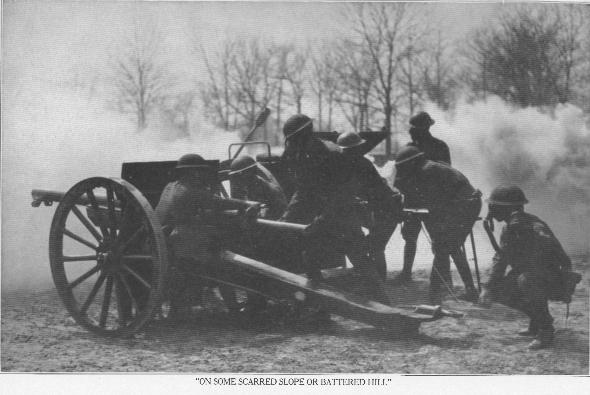

From the Meuse-Argonne front the perpendicular distance to the Carignan-Mezieres railroad was 50 kilometers. This region formed the pivot of German operations in northern France, and the vital necessity of covering the great railroad line into Sedan resulted in the convergence on the Meuse-Argonne front of the successive German defensive position. It will be seen, for example, that the distance between "no manís land" and the third German withdrawal position in the vicinity of the Meuse River was approximately, 18 kilometers: the distance between the corresponding points near the tip of the great salient of the western front was about 65 kilometers. and in the vicinity of Cambrai was over 30 kilometers. The effect of a penetration of 18 kilometers by the American Army would be equivalent to an advance of 65 kilometers farther west; furthermore, such an advance on our front was far more dangerous to the enemy than an advance elsewhere. The vital importance of this portion of his position was fully appreciated by the enemy, who had suffered tremendous losses in 1916 in attempting to improve it by the reduction of Verdun. As a consequence it had been elaborately fortified, and consisted of practically a continuous series of positions 20 kilometers or more in depth.
In addition to the artificial defenses, the enemy was greatly aided by the natural features of the terrain. East of the Meuse the dominating heights not only protected his left but gave him positions from which powerful artillery could deliver an oblique fire on the western bank. Batteries located in the elaborately fortified Argonne forest covered his right flank, and could cross their fire with that of the guns on the east bank of the Meuse. Midway between the Meuse and the forest the heights of Montfaucon offered perfect observation and formed a strong natural position which had been heavily fortified. The east and west ridges abutting on the Meuse and Aire River valleys afforded the enemy excellent machine-gun positions for the desperate defense which the importance of the position would require him to make. North of Montfaucon densely wooded and rugged heights constituted natural features favorable to defensive fighting.
32. When The First Army became engaged in the simultaneous preparation for two major operations an interval of 14 days separated the initiation of the two attacks. During this short period of the movement of the immense number of troops and the amount of supplies involved in the Meuse-Argonne battle, over the few roads available, and confined entirely to the hours of darkness, was one of the most delicate and difficult problems of the war. The concentration induded 15 divisions of which 7 were involved in the pending St. Mihiel drive, 3 were in sector in the Vosges, 3 in the neighborhood of Soissons, 1 in a training area, and 1 near Bar-le-Duc. Practically all the artillery, aviation, and other auxiliaries to be employed in the new operations were committed to the St. Mihiel attack and therefore could not be moved until its success was assured. The concentration of all units not to be used at St. Mihiel was commenced immediately, and on September 13, the second day of St. Mihiel, reserve divisions and Army Artillery units were withdrawn and placed in motion toward the Argonne front.
That part of the American sector from Fresnes-en-Woevre, southeast of Verdun, to the western edge of the Argonne Forest, while nominally under my control, did not actively become a part of my command until September 22, on which date my headquarters were established at Souilly, southwest of Verdun. Of French troops, in addition to the Second French Colonial Corps, composed of 3 divisions, there was also the Seventeenth French Corps of 3 divisions holding the front north and east of Verdun.
Continue
Back
Table of Contents
Back to Legacy